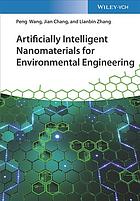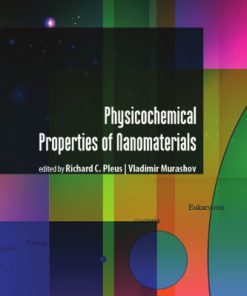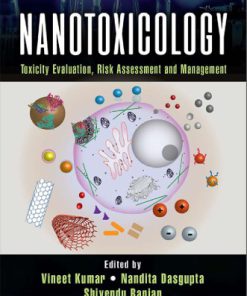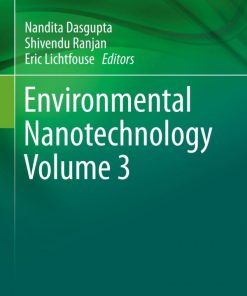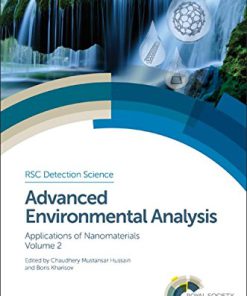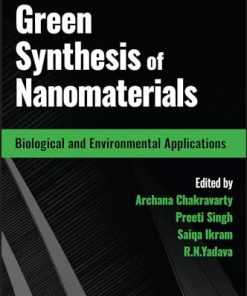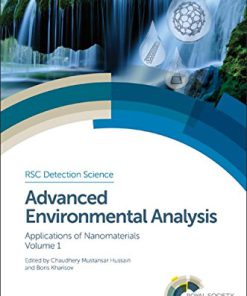Environmental Toxicity of Nanomaterials 1st Edition by Vineet Kumar ISBN 1351252941 9781351252942
$50.00 Original price was: $50.00.$25.00Current price is: $25.00.
Environmental Toxicity of Nanomaterials 1st Edition by Vineet Kumar – Ebook PDF Instant Download/Delivery: 1351252941, 9781351252942
Full download Environmental Toxicity of Nanomaterials 1st Edition after payment

Product details:
ISBN 10: 1351252941
ISBN 13: 9781351252942
Author: Vineet Kumar
Environmental Toxicity of Nanomaterials focuses on causes and prevention of environmental toxicity induced by various nanomaterials. In sixteen chapters it describes the basic principles, trends, challenges, and future directions of nanoecotoxicity. The future acceptance of nanomaterials in various industries depends on the impacts of nanomaterials on the environment and ecosystem. This book analyzes the safe utilization of nanotechnology so the tremendous prospect of nanotechnology can be achieved without harming either living beings or the environment. Environmental Toxicity of Nanomaterials introduces nanoecotoxicity, describes various factors affecting the toxicity of nanomaterials, discusses various factors that can impart nanoecotoxicity, reviews various studies in the area of nanoecotoxicity evaluation, and describes the safety and risk assessment of nanomaterials. In addition, the book discusses strategies for mitigating nanoecotoxicity. Lastly, the authors provide guidelines and protocols for nanotoxicity evaluation and discuss regulations for safety assessment of nanomaterials. In addition to environmental toxicologists, this book is aimed at policy makers, industry personnel, and doctoral and postdoctoral scholars.
Environmental Toxicity of Nanomaterials 1st Table of contents:
Chapter 1 Toxic Effects of Nanomaterials on Environment
1.1 Introduction
1.2 Risk and Hazard of Exposure to Nanomaterials
1.3 Fate and Behavior of Nanomaterials in the Environment
1.3.1 Fate and Behavior of Nanomaterials in Air
1.3.2 Fate and Behavior of Nanomaterials in Water
1.3.3 Environmental Fate of Nanomaterials in Soil
1.4 Human Exposure
1.4.1 Exposure through Inhalation
1.4.2 Exposure through Dermal Deposition
1.4.3 Exposure through Ingestion
1.5 Bioaccumulation of Nanomaterials
1.6 Effect of Nanomaterials on Agriculture and Food
1.7 Conclusion
References
Chapter 2 Nanotoxicity: Impact on Health and Environment
2.1 Introduction
2.2 Nanotoxicity Generated by Industrial Processes and Products
2.2.1 Textile Industry
2.2.2 Pharmaceuticals
2.2.3 Cosmetics
2.2.4 Electronics and Household Appliances
2.2.5 Construction
2.2.6 Automobiles
2.2.7 Pesticides
2.3 Nanomaterial-Induced Toxicity
2.3.1 Effects of Nanoparticles on Terrestrial Environment
2.3.2 Effect of Nanotoxicity on Aquatic Environment
2.3.3 Nanotoxicity Risks within the Food Chain
2.3.3.1 Nanoparticle Transfer within the Food Chain of Terrestrial System
2.3.3.2 Nanoparticle Transfer within the Food Chain of the Aquatic System
2.4 Mechanisms of Nanotoxicity
2.5 Nanotoxicity Risk Assessment
2.6 Conclusions
Acknowledgments
References
Chapter 3 Nanotoxicological Evaluation in Marine Water Ecosystem: A Detailed Review
3.1 Introduction
3.2 Nanotoxicity and Marine Organisms
3.2.1 In Vivo Toxicity Testing of Nanomaterials in Marine Ecosystem
3.2.2 In Vitro Toxicity Testing of Nanomaterials in Marine Ecosystem
3.2.3 Mesocosms: Studying Marine Ecosystems in Stabilized Environments
3.3 Conclusions
Acknowledgments
References
Chapter 4 Interaction of Carbon Nanomaterials with Biological Matrices
4.1 Introduction to Nanotechnology and Toxicology
4.2 Carbon Nanotubes
4.2.1 Synthesis and Dispersion of Carbon Nanotubes
4.2.2 Characterization of Carbon Nanotubes
4.2.3 Enzyme Immobilization and Application of Carbon Nanotubes
4.2.4 Cellular Uptake and Interaction with Complement System
4.2.5 Biomedical Applications of Carbon Nanotubes
4.2.5.1 Drug Delivery
4.2.5.2 Bone Tissue Regeneration and Engineering
4.2.5.3 Carbon Nanotubes as Field Emitters and Composites
4.2.5.4 Gene Delivery
4.2.5.5 Biomedical Imaging
4.2.5.6 Photothermal Cancer Therapy
4.2.6 Toxicity of Carbon Nanotubes
4.2.7 Interaction Studies with Biomolecules
4.3 Conclusion
References
Chapter 5 Interaction of Inorganic Nanoparticles with Biological Matrices
5.1 Introduction
5.1.1 Gold Nanoparticles
5.1.2 Silver Nanoparticles
5.1.3 Quantum Dots
5.1.4 Silica Nanoparticles
5.1.5 Titanium Oxide Nanoparticles
5.2 Biological Matrices
5.2.1 Carbohydrates, Proteins, and Nucleic Acids
5.2.2 Collagen
5.2.3 Xenogeneic Extracellular Matrices
5.2.4 Hydrogels
5.3 Interactions of Inorganic Nanoparticles with Biological Matrices
5.3.1 Interaction of Gold Nanoparticles with Biological Matrices
5.3.1.1 Interaction with Blood
5.3.1.2 Interaction with Proteins
5.3.1.3 Interaction with Different Tissues/Organs
5.3.2 Interaction of Silver Nanoparticles
5.3.2.1 Interaction with Mitochondria
5.3.2.2 Interaction with DNA
5.3.2.3 Interaction with Proteins
5.3.3 Interactions of Quantum Dots with Biological Matrices
5.3.3.1 Interaction with Skin
5.3.3.2 Interaction with Proteins
5.3.4 Interactions of Silica Nanoparticles
5.3.4.1 Interaction with Proteins
5.3.4.2 Interaction with DNA
5.4 Conclusion
References
Chapter 6 Effects of Engineered Nanoparticles on Bacteria
6.1 Introduction
6.2 Carbon Nanomaterials
6.2.1 Bacterial Toxicity of Graphene-Based Nanomaterials
6.2.1.1 Cytotoxicity
6.2.1.2 Lack of Cytotoxicity
6.3 Bacterial Toxicity of Other Carbon Nanomaterials
6.4 Cytotoxicity Mechanisms
6.5 Cytotoxicity of Metal-Based Nanomaterials
6.6 Cytotoxicity Mechanisms Depending on the Kind of Cell, the Medium, and the NPs
6.7 Reliability of Assay Methods
6.8 Summary and Future Perspectives
References
Chapter 7 Comparative Risk Assessment of Copper Nanoparticles with Their Bulk Counterpart in the Indian Major Carp Labeo rohita
7.1 Introduction
7.2 Materials and Method
7.2.1 Collection of Experimental Animals
7.2.2 Toxicant
7.2.3 Acute Toxicity Study
7.2.3.1 Collection and Preparation of Samples
7.2.3.2 Ionoregulation Studies
7.2.3.2.1 Sodium Assay
7.2.3.2.2 Potassium Assay
7.2.3.2.3 Chloride Assay
7.2.3.2.4 Enzymological Studies
7.2.3.2.5 Statistical Analysis
7.3 Results
7.4 Discussion
7.5 Conclusion
Acknowledgment
References
Chapter 8 Toxic Effects of Nanomaterials to Plants and Beneficial Soil Bacteria
8.1 Introduction
8.2 Involvement of Plants and Microbes in Nanoparticle Synthesis
8.2.1 Phytosynthesis of NPs
8.2.2 Microbial Synthesis of Nanoparticles
8.3 Effect of Nanoparticles on Plant Growth-Promoting Bacteria
8.4 Effect of Nanoparticles on Plant Health
8.5 Processing of Nanoparticles Containing Products after Use
References
Chapter 9 Nanotoxicity of Silver Nanoparticles: From Environmental Spill to Effects on Organisms
9.1 Introduction
9.2 Physical and Chemical Behavior and Fate of Silver Nanoparticles in Aquatic Systems
9.2.1 Single Nanoparticle and Individual Behavior
9.2.1.1 Oxidation–Dissolution
9.2.1.2 Sulfidation
9.2.2 Multiple Particles or Group Behavior
9.2.2.1 Aggregation
9.2.2.2 Interaction or Sorption with Natural Organic Matter
9.3 Effects of AgNPs on Aquatic Organisms
9.3.1 Nanoparticles and Prokaryotes
9.3.1.1 Potential Antimicrobial Mechanisms of AgNPs
9.3.1.2 Effects of AgNPs on Complex Natural Bacterial Communities
9.3.2 Effects of AgNPs on Phytoplankton
9.3.2.1 Effects and Mechanisms of AgNPs on Phytoplankton
9.3.2.1.1 Interactions of AgNPs with Microalgae
9.3.2.1.2 Toxic Effects of AgNPs on Microalgae
9.3.2.1.3 Effects of AgNPs on Mitochondria and Chloroplasts
9.3.2.1.4 Silver Detoxification Process of Microalgae
9.3.2.2 Varying Sensitivity to AgNPs Depending on the Species
9.3.3 Effects of AgNPs on Zooplankton
9.3.3.1 Physical Interactions of AgNPs with Zooplankton
9.3.3.2 Toxic Effects of AgNPs to Zooplankton
9.3.3.3 Influence of Environmental Conditions on AgNP Toxicity to Zooplankton
9.3.4 Behavior and Impact of AgNPs on Eukaryotic Macroorganisms
9.3.4.1 Acute Toxic and Sublethal Effects of AgNPs on Young and Mature Marine Invertebrates
9.3.4.2 Toxicity to Fish Early Developmental Stages and Adults
9.3.4.2.1 Early Toxicity Assays and Observations
9.3.4.2.2 Recent Progress in AgNP Toxicity Mechanisms in Fish
9.4 Conclusion
References
Chapter 10 Nanotoxicity on Human and Plant Pathogenic Microbes and Aquatic Organisms
10.1 Introduction
10.1.1 Nanoparticle Type, Source, and Exposure
10.1.2 Characterization of Nanoparticles
10.1.3 Uptake and Internalization of Nanoparticles in Live Cells
10.1.4 Effect of Nanoparticles on Toxicity Assays
10.1.4.1 Nanoparticle Toxicity to Humans
10.2 In Vivo Nanoparticle Toxicology: Impact on Human Health
10.2.1 Nanoparticle Toxicity following Respiratory Exposure
10.2.2 Nanoparticle Toxicity following Dermal Exposure
10.2.3 Nanoparticle Toxicity following Oral Exposure
10.2.4 Nanoparticle Toxicity following Injection
10.3 In Vitro Study of Nanoparticle Toxicity: Cellular Mechanisms
10.3.1 In Vitro Studies of Nanoparticle Toxicity
10.4 Nanoparticle Toxicity to Plant Pathogenic Microbes
10.4.1 Antibacterial Activity of Nanoparticles
10.4.2 Antifungal Activity of Nanoparticles
10.4.2.1 Silver Nanoparticle: Protection against Phytofungal Diseases
10.5 Nanoparticle Toxicity to Aquatic Organisms
10.5.1 Uptake of Nanoparticles by Aquatic Organisms
10.5.1.1 Uptake Studies of Carbon Nanoparticles
10.5.1.2 Uptake Studies of Metal-Based Nanoparticles
10.5.2 Nanoparticle Toxicity in Fish
10.5.3 Nanoparticle Toxicity in Phytoplanktons
10.5.4 Nanoparticle Toxicity in Crustaceans
10.5.5 Nanoparticle Toxicity in Mollusks
10.6 Conclusion
References
Chapter 11 Methods of In Vitro and In Vivo Nanotoxicity Evaluation in Plants
11.1 Introduction
11.2 Nanomaterials and Model Plant Systems
11.2.1 Nanomaterials Needing Urgent Safety Appraisal
11.2.2 Model Plant Systems Used for Nanotoxicity Testing
11.3 Characterization of Nanoparticles
11.3.1 Preparation of Nanoparticle Dispersions
11.3.2 Physicochemical Characterization
11.4 Plant Growth Conditions
11.4.1 In Vivo Test Systems
11.4.2 In Vitro Cell Suspensions
11.5 Methods of Adsorption, Internalization, and Biodistribution Study
11.6 Assessment of Phytotoxicity
11.6.1 Germination and Growth Parameters
11.6.2 Cell Viability Studies
11.7 Genotoxicity Methods
11.7.1 Cytogenetic Studies
11.7.2 Single-Cell Gel Electrophoresis (Comet Assay)
11.7.3 DNA Laddering
11.7.4 Terminal Deoxynucleotidyl Transferase-Mediated Deoxyuridinetriphosphate–Nick Labeling Assay
11.8 Detection of ROS
11.8.1 Detection of OH•, ROO• Radicals, and H2O 2 by DCFH-DA Assay
11.8.2 Estimation of H2O 2 Content
11.9 Conclusions and Future Perspectives
Acknowledgment
References
Chapter 12 In Vitro and In Vivo Nanotoxicity Evaluation in Plants
12.1 Introduction
12.2 Types of Nanoparticles
12.3 Behavior of Nanoparticles
12.3.1 Mobility of Nanoparticles
12.3.2 Redox Transformations
12.3.3 Degradability
12.3.4 Fate and Behavior of Nanoparticles in the Environment
12.3.4.1 Air
12.3.4.2 Water
12.3.4.3 Soil
12.4 Ecotoxicity of Nanoparticles
12.5 Toxicity of Nanoparticles on Plant Growth
12.5.1 Carbon-Based Nanomaterials
12.5.1.1 Single-Walled Carbon Nanotubes
12.5.1.1.1 In Vitro Evaluation
12.5.1.1.2 In Vivo Evaluation
12.5.1.2 Multiwalled Carbon Nanotubes
12.5.1.2.1 In Vitro Evaluation
12.5.1.2.2 In Vivo Evaluation
12.5.1.3 Fullerenes
12.5.1.3.1 In Vitro Evaluation
12.5.1.3.2 In Vivo Evaluation
12.5.2 Magnetic Nanoparticles
12.5.2.1 In Vitro Evaluation
12.5.2.2 In Vivo Evaluation
12.5.3 Metal- and Metal Oxide-Based Nanomaterials
12.5.3.1 Nano-TiO2
12.5.3.1.1 In Vitro Evaluation
12.5.3.1.2 In Vivo Evaluation
12.5.3.2 Aluminum-Based Nanoparticles
12.5.3.2.1 In Vitro Evaluation
12.5.3.2.2 In Vivo Evaluation
12.5.3.3 Zinc-Based Nanoparticles
12.5.3.3.1 In Vitro Evaluation
12.5.3.3.2 In Vivo Evaluation
12.5.3.4 Copper (Cu) Nanoparticles
12.5.3.4.1 In Vitro Evaluation
12.5.3.4.2 In Vivo Evaluation
12.5.3.5 Silver (Ag) Nanoparticles
12.5.3.5.1 In Vitro Evaluation
12.5.3.5.2 In Vivo Evaluation
12.5.3.6 Silica Nanoparticles
12.5.3.6.1 In Vitro Evaluation
12.5.3.6.2 In Vivo Evaluation
References
Chapter 13 Phytochemicals and Their Functionalized Nanoparticles as Quorum Sensing Inhibitor and Chemotherapeutic Agent
13.1 Introduction
13.2 Quorum Sensing
13.3 Quorum Sensing and Quorum Quenching Strategies
13.4 Phytochemical-Based Quorum Sensing Inhibitors
13.5 Phytochemical-Functionalized NPs as QSI
13.6 Chemically Modified NPs as QSI
13.7 Conclusions
Acknowledgment
References
Chapter 14 Nanotoxicological Evaluation in Freshwater Organisms
14.1 Introduction
14.2 Transport, Transformation, and Fate of Nanomaterials
14.2.1 Environmental
14.2.1.1 Recommendations for Future Econanotoxicological Assessments
14.2.2 Biological
14.2.2.1 Absorption and Uptake
14.2.2.1.1 Recommendations for Future Cellular Uptake Methods
14.2.2.2 Distribution, Metabolism, and Excretion
14.3 Factors Modulating Nanomaterial Toxicity
14.3.1 Size, Agglomeration, and Surface Charge
14.3.2 Dissolution
14.3.3 Surface Functionalization
14.3.4 Natural Organic Matter
14.3.5 Ultraviolet Light
14.4 Metrics of Nanotoxicity Testing and Associated Challenges
14.5 Test Guidelines for Evaluation and Interpretation of Nanotoxicological Effects
14.6 Toxicological Assessment of Nanomaterials
14.6.1 Cerium Oxide Nanomaterials
14.6.2 Iron Oxide Nanomaterials
14.6.3 Titanium Dioxide Nanomaterials
14.6.4 Zinc Oxide Nanomaterials
14.6.5 Single-Walled Carbon Nanotubes
14.6.6 Cellulose Nanocrystals
14.7 Aquatic Freshwater Animal Models
14.8 Outlook
References
Chapter 15 Guidelines and Protocols for Nanotoxicity Evaluation
15.1 Introduction
15.2 Guidelines for Nanotoxicity Evaluation
15.2.1 Organisation for Economic Co-Operation and Development
15.2.1.1 OECD Guidelines for Testing of Chemicals
15.2.1.2 OECD Guidelines for Dosage
15.2.1.3 OECD Guideline for Exposure Route of the Nanoparticles to the System
15.2.1.4 OECD Guidelines for Observation Period
15.2.1.4.1 Body Weight and Food/Water Consumption
15.2.1.4.2 Hematology
15.2.1.4.3 Clinical Biochemistry
15.2.1.4.4 Pathology
15.2.1.4.5 Histopathology
15.2.1.4.6 Common Mechanism for Cytotoxicity
15.2.2 World Health Organization/Food and Agricultural Organization
15.2.3 United Nations
15.2.4 International Organization for Standardization
15.2.5 Other Guidelines
15.3 Protocols for Nanotoxicology Evaluation
15.3.1 Cytotoxicity Evaluation
15.3.1.1 In Vitro Methods
15.3.1.1.1 Trypan Blue Exclusion
15.3.1.1.2 Microculture Tetrazolium Assay
15.3.1.1.3 LDH Leakage Assay
15.3.1.2 In Vivo Methods
15.3.1.2.1 Lactate Dehydrogenase Assay
15.3.1.2.2 Apoptosis Assay
15.3.2 Genotoxicity Evaluation
15.3.2.1 In Vitro Methods
15.3.2.1.1 Ames Test
15.3.2.1.2 Comet Assay
15.3.2.2 In Vivo Methods
15.3.2.2.1 Micronucleus Test with Cytokinesis Block (MNCtB)
15.3.2.2.2 Biochemical Assays
15.3.2.2.3 ROS Mechanism
15.3.2.2.3.1 Fluorescent and Chemiluminescent Assays
15.3.2.2.3.2 Nitric Oxide Assay
5.3.2.2.3.3 Electron Spin Resonance Assay
15.3.2.2.3.4 Lipid Peroxidation Assay
15.3.2.2.3.5 Glutathione Peroxidase Assay
15.3.2.3 Microscopic Analysis
15.3.2.3.1 Light Microscopy
15.3.2.3.2 Electron Microscopy for Biological Samples
15.3.3 Importance and Significance
15.4 Conclusions
Acknowledgments
References
Chapter 16 Regulations for Safety Assessment of Nanomaterials
16.1 Introduction: The Need for Nanoparticle Regulation and Their Expanding World
16.2 Problems in Regulating the Toxicity of Nanoparticles
16.2.1 Uncertainty Regarding Nanomaterial Risks
16.2.2 Rapid Technology Change
16.2.3 Uncertainty of Commercialization Paths
16.2.4 Uncertainty Regarding the Suitability of Regulatory Frameworks
16.3 Nanoparticle Regulations across the World
16.3.1 Europe
16.3.1.1 Registration, Evaluation, and Authorisation of Chemicals
16.3.1.1.1 REACH and Nanomaterials
16.3.1.1.1.1 Identification of Nanomaterials
16.3.1.1.1.2 The “Phase-In” Status of Nanomaterials
16.3.1.1.1.3 Tonnage Threshold and Nanomaterials
16.3.1.1.1.4 Risk Assessment Provisions
16.3.1.1.2 Attempts to Fill the Gaps of REACH
16.3.1.2 Pharmaceutical Regulations
16.3.1.2.1 Difficulty in Identification of a Nanomedicinal Product
16.3.1.2.2 Difficulty in Characterizing a Nanomedicinal Product
16.3.1.2.3 “Nanosimilars”
16.3.1.2.4 “Next-Generation” Nanomedicines
16.3.1.3 Agriculture and Nanofood Regulations
16.3.1.4 Water Protection
16.3.2 United States
16.3.2.1 Food and Drug Administration
16.3.2.1.1 Final Guidance for Industry: Considering Whether an FDA-Regulated Product Involves the Application of Nanotechnology
16.3.2.1.2 Final Guidance for Industry: Safety of Nanomaterials in Cosmetic Products
16.3.2.1.3 Final Guidance for Industry: Assessing the Effects of Significant Manufacturing Process Changes, Including Emerging Technologies, on the Safety and Regulatory Status of Food Ingredients and Food Contact Substances, Including Food Ingredients That Are Color Additives
16.3.2.1.4 Final Guidance for Industry: Use of Nanomaterials in Food for Animals
16.3.2.1.5 Regulatory Strategies of FDA
16.3.2.2 US Environmental Protection Agency
16.3.2.2.1 Premanufacture Notifications for New Nanomaterials
16.3.2.2.2 Information Gathering Rule on New and Existing Nanomaterials
16.3.2.3 National Institute of Occupational Safety and Health
16.3.2.4 Drawbacks of the US Regulatory Approach on Nanotechnology and Nanomaterials
16.3.2.4.1 “Fit” Problem
16.3.2.4.2 Defining Nanotechnology
16.3.2.4.3 Uncertainty Problem
16.3.2.4.4 Other Factors
16.4 Conclusion
People also search for Environmental Toxicity of Nanomaterials 1st:
environmental toxicity of nanomaterials
toxicity and environmental risks of nanomaterials
comparative environmental fate and toxicity of copper nanomaterials
how to reduce toxicity of nanoparticles
environmental impact of nanotechnology
Tags:
Vineet Kumar,Environmental,Toxicity,Nanomaterials
You may also like…
Technique - Nanotechnology
Nanotoxicology : Toxicity Evaluation, Risk Assessment and Management First Edition Dasgupta
Engineering - Environmental
Engineering - Environmental
Engineering
Total Petroleum Hydrocarbons Environmental Fate Toxicity and Remediation Saranya Kuppusamy
Engineering - Industrial Engineering & Materials Science
Green Synthesis of Nanomaterials: Biological and Environmental Applications 1st Edition Chakravarty




